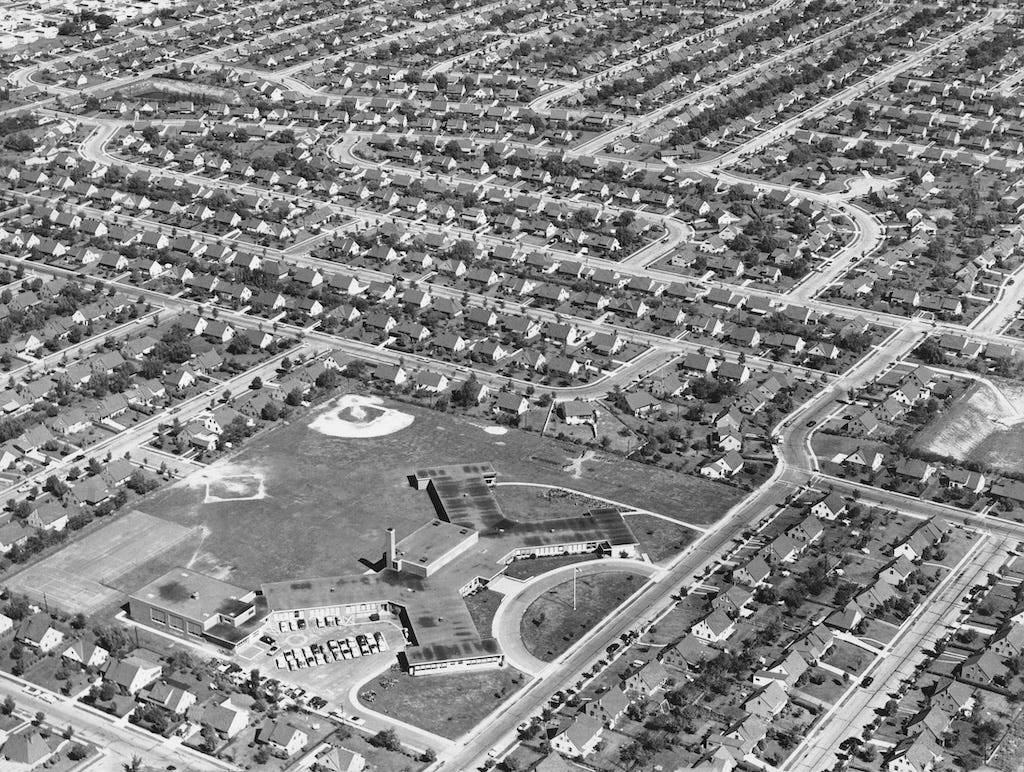Seeds of change
The transition to suburban living took much longer than we think, and the transition away has already started
When we think of post-war America we tend to think of a simple story. After the war, newly prosperous Americans got cars, built freeways, and moved to the suburbs. This story has an element of truth: we certainly did move to the suburbs after the war. But, perhaps surprisingly, our mental model of how that happened is very out of order:
We started building what we’d largely recognize as the first suburbs in the 1860s (see Riverside, IL).
Americans mostly got cars after the first world war, not the second. We reached one car per household in 1929, and suburbs like Country Club Plaza were being built in the 1920s with car-orientation as a primary design consideration.
The Federal-Aid Highway Act to create the Interstates was passed in 1956, but development largely took place in the 60s and 70s, and wasn’t declared complete until 1992!
That timeline of major events is correct, but it seems wrong, because it’s missing the moment where America realized something was different. Hidden between points two and three is the suburban explosion kicked off by Levittown in 1947.
This isn’t actually surprising; it’s how the history of technology and social change always goes. There’s a long period of discovery and innovation where the fundamental building blocks come into place. Then there’s a long period of experimentation and integration where technology is used to enhance the status quo. Finally, sometimes, there’s a revolution, where society realizes that things have changed and starts to re-orient itself around the change.
Levittown is important not because it invented the suburbs or proved that people would live in a car-dependent neighborhood; it matters because Levittown took a bunch of ideas and technology that had already been around for a generation, integrated them better, and delivered them at scale in a way that captured the attention and imagination of the country. When people saw Levittown, they knew they were seeing the future.
But more than one generation of groundwork led up to that moment.
I think that we’re in a remarkably similar situation today, with many of the seeds of the next revolution already planted and beginning to bloom. For yesterday’s J.C. Nichols we have today’s Andres Duany. For yesterday’s rise of the automobile, we have today’s rise of micromobility, autonomy, and remote work. And for the post-war housing crisis, we have... today’s housing crisis.
Today, about half the country lives in conventional, post-war suburbs that look and feel remarkably like Levittown. I think we’re near the peak, and much as our inner cities lost their appeal in the 60s and 70s as we enthusiastically embraced the suburban model, I think we’ll eventually see today’s suburban development lose its luster after the next, better model emerges and captures our collective imagination.
The exciting question for now is how the Post-Suburban pattern will work, where the model will emerge, and how quickly it will spread.






Perhaps wishful thinking but we may already be experiencing the slow part - people forsaking cities and their suburban extensions in favor of repopulating our abandoned towns.
Nice piece Andrew. I love how applicable this old Hemingway quote can be: “gradually, then suddenly.” The move to the Suburbs was not as simple as most make it out to be. It happened gradually, then suddenly.